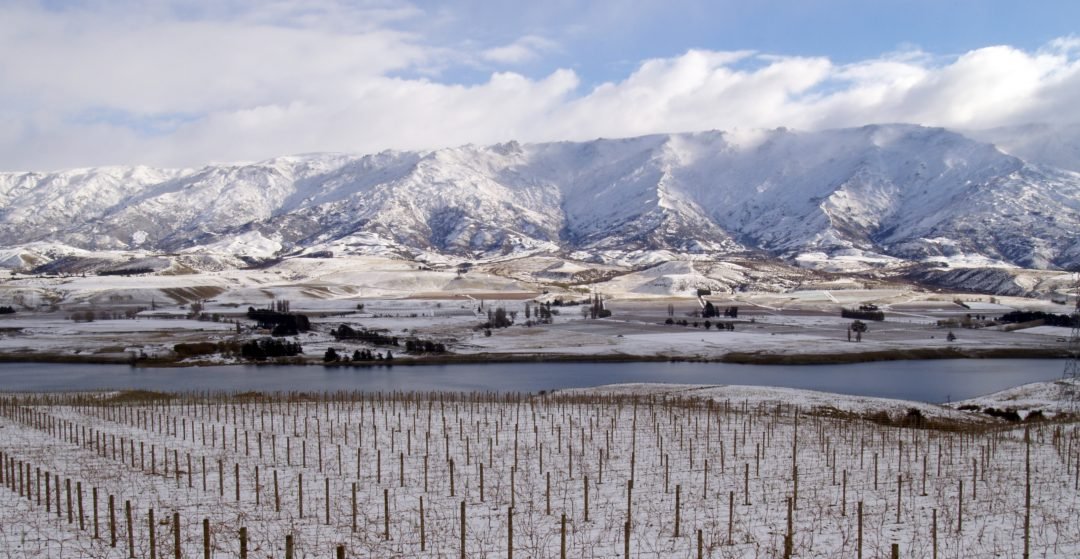Photo credit: Misha’s Vineyard/ NZ Winegrowers
The Central Otago on New Zealand’s South Island is famous for Pinot Noir. Wine has been produced in this rugged, mountainous region since the heady days of the 1860s Gold Rush. Today, as critical acclaim continues to grow for Central Otago Pinot Noir, the diverse styles of each vineyard sub-region are gaining in recognition.
Regional Overview
The Central Otago is a land formed by glacier activity and the many lakes and rivers that traverse the region. At its most northerly point, the Central Otago crosses the 45th parallel south. According to the New Zealand Winegrowers organization, Central Otago is the world’s most southerly commercial wine region.
Ancient mountains, many rising well over 2000 metres, shelter the Central Otago region from the maritime influences that define all other New Zealand wine growing areas. While meso-climates vary significantly, in general Central Otago has a dry, semi-continental climate with strong diurnal variation.
The region’s exceptionally high UV light levels give deep colour to many of its Pinot Noir. Soil composition is also varied, but stony, free-draining subsoils are common, with schist or greywacke bedrocks.
A mere 1,930 hectares of vineyards spread across the slope sides and valleys of Central Otago. Pinot Noir accounts for 80% of these plantings. The reputation the region has carved out internationally for Central Otago Pinot Noir stems in part from this monovarietal dedication.
Central Otago Pinot Noir Styles by Sub-Region
Due to the region’s diverse terrain and multitude of mesoclimates, the growing areas are divided into multiple sub-regions, all offering a different expression of Central Otago Pinot Noir. From north to south, Central Otago’s sub-regions include:
Wanaka
Wanaka, the smallest sub-region, is situated 80km northeast of Queenstown. The vineyards surround Lake Wanaka, on gravel and silt-based soils overlying a schist bedrock. These soils provide excellent drainage, encouraging the vine to root deeply.
This is among the cooler sub-regions, marked by cold winters, rainy spring weather, warm, dry summers, and long, temperate autumn conditions that allow for excellent ripening while preserving lively acidity.
Central Otago Pinot Noir from Wanaka is often described light, delicate, and very elegant in style, with intense, bright red fruit flavours. Producers of note include: Rippon, Maude Wines, and Akitu.
Bendigo
Moving southeast across the mountains, east of the Clutha River, bordering Lake Dunstan lie the stony, hillside vineyards of Bendigo. This is the largest and warmest sub-region in Central Otago.
The vineyards are planted on moderate slopes of 200 to 350 metres in altitude in the foothills of the Dunstan Mountains. They are oriented north to abundant sunshine. Conditions are hot and dry here, and there is significant diurnal variation preserving fresh acidity.
The Central Otago Pinot Noir from Bendigo is among the ripest, most full-bodied, and tannic styles of the region, balanced by fresh acidity. Wineries to watch include: Prophet’s Rock, Quartz Reef, and Balgownie Estate.
Cromwell/Lowburn/Pisa
The trio of Cromwell/Lowburn/Pisa includes low terraces and valley floor vineyard sites stretching 25 kilometres northward from the township of Cromwell. They sit along the western shore of Lake Dunstan, parallel to the Pisa Mountain range.
The climate is dry and warm, with temperature extremes moderated by the lake. Soils are quite diverse, with large areas of sandy-loam, and of gravelly, schist- based zones at higher elevations in Lowburn.
This early ripening area produces supple, approachable, generously fruited styles of Central Otago Pinot Noir, with silky tannins. Great producers from this region include: Burn Cottage, Wild Earth, Rockburn.
Gibbston
Gibbston is the highest altitude and coolest of all Central Otago sub-regions. It is located along the Kawarau Gorge, directly east of Queenstown. Vineyards are planted from 320 to 420 metres above sea level on northern exposures.
The areas’ soils are composed of loess with underlying layers of schist rocks and alluvial gravel. This is a late ripening area that can be quite rainy, experiencing more vintage variation than more easterly sites.
Central Otago Pinot Noir from Gibbston is described as light and ethereal, with fragrant red berries, fresh herbs, and mixed spices on the nose. It is generally soft on the palate. Top wineries include: Valli, Peregrine, Mount Edward, and Gibbston Valley.
Bannockburn
Southwest of Cromwell lies Bannockburn, a very warm, dry, early ripening sub-region. It is located on the southern shore of the Kawarau River, by the Cairnmuir Mountains.
The soils of Bannockburn are remarkably diverse. A long history of mining in the area, has left heavy deposits of gravel in certain vineyard sites. Other gravel-rich sites, of schist and greywacke, are naturally occurring. Elsewhere, pockets of heavy clay loam and sandy loam exist.
Central Otago Pinot Noir from Bannockburn is renowned for its dense, concentrated dark fruit flavours and bold tannic structure. Notable wineries in the area include: Felton Road, Mt. Difficulty, Doctor’s Flat, Ceres, Akarua
Alexandra
Alexandra is the most southerly of Central Otago’s sub-regions. It is situated in a mountain basin, bordering the Clutha River. Marked continentality, in the way of very hot, dry summers and exceptionally cold winters, define the climate.
Compared to Queenstown, Alexandra sees over 100 additional sunshine hours each year, and 600 millimetres less rainfall. The region’s wide temperature swings give highly aromatic, lively wines. Free draining alluvial gravel and loess soils dominate here.
Central Otago Pinot Noir from Alexandra is known for its fragrant aromatics, fine structure, and signature dried thyme notes. Excellent producers from this region include: Grasshopper Rock, Black Ridge, Three Miners.
*** This Central Otago Pinot Noir article was written for SOMM360 Want to learn more about wine & spirits? Check out their excellent learning platform for articles, audio capsules, and loads of fun quizzes to test your knowledge. ***



